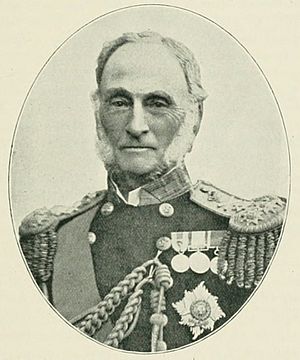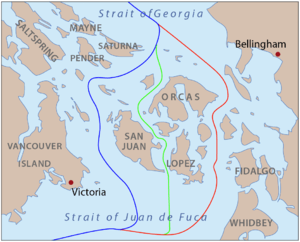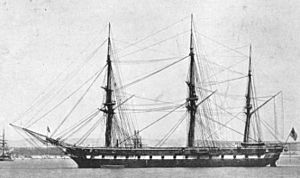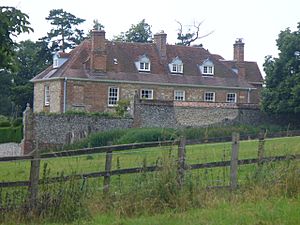Geoffrey Hornby facts for kids
Quick facts for kids
Sir Geoffrey Hornby
|
|
|---|---|

Sir Geoffrey Hornby
|
|
| Born | 10 February 1825 Winwick, Lancashire |
| Died | 3 March 1895 (aged 70) Lordington House, Sussex |
| Allegiance | |
| Service/ |
|
| Years of service | 1837–1895 |
| Rank | Admiral of the Fleet |
| Commands held | Portsmouth Command Royal Naval College, Greenwich Mediterranean Fleet Channel Squadron Flying Squadron West Africa Squadron HMS Edgar HMS Neptune HMS Tribune |
| Battles/wars | Egyptian–Ottoman War Pig War |
| Awards | Knight Grand Cross of the Order of the Bath |
| Relations | Admiral Sir Phipps Hornby (father) James John Hornby (brother) Edmund Phipps-Hornby (son) |
Admiral of the Fleet Sir Geoffrey Thomas Phipps Hornby (born February 10, 1825 – died March 3, 1895) was a very important officer in the Royal Navy. As a young officer, he took part in the capture of Acre in November 1840 during the Egyptian–Ottoman War.
Later, as a captain, he was sent to Vancouver Island. There, he found American soldiers ready to take over the San Juan Islands. This disagreement became known as the Pig War. Captain Hornby used his excellent diplomacy skills to help hand over the islands peacefully to the United States.
Hornby went on to lead several important naval groups. He was Commander-in-Chief of the West Africa Squadron. He also led the Flying Squadron and the Channel Squadron. Later, he became Commander-in-Chief of the Mediterranean Fleet. He was also President of the Royal Naval College, Greenwich. His final big role was Commander-in-Chief, Portsmouth.
Contents

Geoffrey Hornby was born on February 10, 1825. His father, Sir Phipps Hornby, was also an Admiral. Geoffrey went to school at Winwick Grammar School and Southwood's School. He joined the Royal Navy in March 1837 when he was just 12 years old.
His first ship was the large HMS Princess Charlotte. This ship was the main vessel for the Commander-in-Chief of the Mediterranean Fleet. In November 1840, he saw action at the capture of Acre. This happened during the Egyptian–Ottoman War.
In August 1842, he moved to HMS Winchester. This ship was based at the Cape of Good Hope Station. He then became an assistant officer on HMS Cleopatra. This ship was part of the West Africa Squadron. They worked to stop the illegal slave trade.
He was promoted to lieutenant on June 15, 1845. In September 1847, he became a flag-lieutenant on HMS Asia. This was his father's ship, who was leading the Pacific Station. He continued to rise through the ranks. He became a commander on January 12, 1850. Then, he became a captain on December 18, 1852.
Diplomacy and Commands
After 1852, Hornby took a break from naval duties. He helped manage his father's estate. He did not take part in the Crimean War. In August 1858, he became the commanding officer of the frigate HMS Tribune. He was stationed on the Pacific Station.
When he arrived at Vancouver Island, he faced a tricky situation. American troops were about to take over the San Juan Islands. This was part of a disagreement called the Pig War. Captain Hornby used his great diplomatic skills. He helped arrange a peaceful handover of the islands to the United States. This avoided a potential conflict.
In February 1861, Hornby took command of HMS Neptune. This ship was part of the Mediterranean Fleet. In May 1863, he became flag captain for the leader of the Channel Squadron. He was on the ship HMS Edgar. In January 1864, his squadron was ordered to follow ships from the Austro-Hungarian Navy. They were told to sink these ships if they attacked Copenhagen. This was during a dispute called the Schleswig-Holstein Question.
He was promoted to commodore in September 1865. He became Commander-in-Chief of the West Africa Squadron. His main ship was the frigate HMS Bristol. He strongly criticized the rulers in West Africa. They were still involved in the slave trade. This was happening even though most civilized countries had already stopped it.
Leading Fleets and Colleges
On January 1, 1869, Hornby was promoted to rear admiral. In June 1869, he became Commander-in-Chief of the Flying Squadron. His main ship was the frigate HMS Liverpool. With this squadron, he sailed around the world. This journey showed that the Royal Navy could reach any part of the globe.
In September 1871, he became Commander-in-Chief of the Channel Squadron. His main ship was the armored frigate HMS Minotaur. During this time, he hosted President Ulysses S. Grant at Gibraltar.
In December 1874, Hornby became the Second Naval Lord. He was promoted to vice admiral on January 1, 1875. In January 1877, he took command of the Mediterranean Fleet. His main ship was the battleship HMS Alexandra. He famously sailed his fleet through the Dardanelles straits. He did this despite protests from Turkey. This show of British naval power was meant to stop Russian aggression. This happened during the Russo-Turkish War.
Many people admired Hornby. Sir John Fisher, who served with him, called him 'the finest Admiral afloat since Nelson'. He said Hornby was 'incomparable'. The naval historian Sir William Clowes described him as a 'natural diplomatist' and a great tactician. Historian Ben Wilson said Hornby was an "exceptional admiral." He helped the Navy change from sailing ships to steam-powered ones. Hornby received a high honor, becoming a Knight Commander of the Order of the Bath on August 12, 1878.
Later Life and Legacy
On June 15, 1879, Hornby was promoted to full admiral. In March 1881, he became President of the Royal Naval College, Greenwich. This is a very important naval training college. In November 1882, he became Commander-in-Chief, Portsmouth. This was a major command.
He received an even higher honor on December 19, 1885. He was made a Knight Grand Cross of the Order of the Bath. On January 18, 1886, he became the First and Principal Naval Aide-de-Camp to the Queen. On May 1, 1888, he reached the highest rank: Admiral of the Fleet.
He also served on the staff of German emperor Wilhelm II. This was during the emperor's visits to England in 1889 and 1890. Hornby retired in February 1895. He sadly died of influenza at Lordington House on March 3, 1895. His ashes were scattered at Compton Church.
Family Life
In 1853, Geoffrey Hornby married Emily Frances Coles. She was the sister of Captain Cowper Phipps Coles. They had three sons and two daughters. One of their sons, Edmund Phipps-Hornby, became a major in the artillery. He won the Victoria Cross in South Africa in 1900. Another son, Robert Hornby, also became an admiral in the Royal Navy.
Images for kids
-
Map of the proposed boundaries between the United States and Canada around the San Juan Islands during the Pig War.






